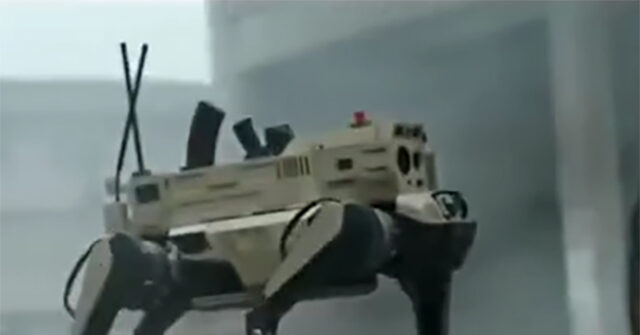Chinese state media reported Wednesday that dog-like mechanical devices dubbed “robot wolves” were added to military exercises by the People’s Liberation Army (PLA).
The new drones appeared to be more refined versions of a design China showed off a year ago, during joint military drills with Cambodia:
China’s state-run Global Times touted the ability of the robot wolves to “achieve coordinated combat,” carry “mission-specific equipment,” and utilize “swarm combat tactics” modeled on the behavior of actual wolf packs.
The drones were depicted firing rifles mounted on their backs, climbing stairs, and navigating difficult terrain. China’s CCTV claimed the robots can “carry out precision strikes from up to 100 meters away.”
The robot packs are supposedly controlled by a “pack leader,” which would transmit reconnaissance information back to human operators and coordinate the other robots in a swarm.
This is similar in concept to aerial drone tactics developed during the Russia-Ukraine War, when both sides realized their drone swarms were vulnerable to electronic warfare and signal jamming. The fewer drones are required to communicate over long distances with human controllers, the more resistant to jamming a drone swarm becomes.
The footage revealed by Chinese media was not too different from propaganda releases of the past, which have long claimed the PLA is developing an unbeatable edge in autonomous infantry drones. Chinese military robots have put on some impressive demonstrations, but their performance under combat conditions remains to be seen.
The U.S. Army has been developing robot dogs, or Quadrupedal-Unmanned Ground Vehicles (Q-UGV), as well. Some of the U.S. designs are armed with rifles, like the Chinese robot wolves, while other designs are more geared toward reconnaissance or carrying equipment.
The U.S. Marines have considered putting anti-tank rocket launchers on their Q-UGVs, but they might actually prove most useful as defense systems against aerial drones. The U.S. military has reportedly developed an A.I. system for quadruped drones that is fairly proficient at targeting the sort of small unmanned aerial vehicles that have become ubiquitous in the Russia-Ukraine conflict.
Read the full article here
